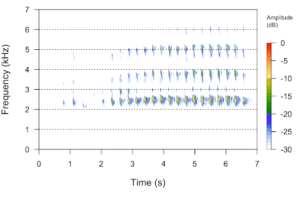American Goshawk
Accipiter atricapillus

American Goshawks are a Species of Greatest Conservation Need in New Hampshire. (photo © Raven.Digital)
The American Goshawk — a large, migratory raptor known for its feisty disposition — is a member of the Accipiter family, which specializes in hunting other birds. (The name “goshawk” translates to “hawk that eats goose.”) As apex predators, goshawks balance forest food webs by preying upon a wide variety of birds, as well as small to medium-sized mammals. Although they breed throughout northern New England, including here in the Monadnock Region, their presence can be difficult to detect. They are most noticeable during an initial vocal period in the early spring, and again in June and July as they defend nests with young.
American Goshawks have experienced a precipitous decline in the eastern United States in the past 50 years, perhaps as a result of forest fragmentation, diminishing prey availability, disease, and/or climate change. In New Hampshire, they are now considered a Species of Greatest Conservation Need.
Tracking (& Tracking Down) Goshawk Breeding Territories
For the last two years, Harris Center staff and interns have been collecting data on local goshawk breeding territories, in order to: (1) better understand existing habitat use and the timing of breeding milestones in the Monadnock Region, and (2) inform future research collaborations with conservation biologists throughout the Northeast and mid-Atlantic states.
Initially, Harris Center bird conservation interns Mike Valentino and Chris Liazos utilized a traditional broadcasting (playback) technique to search for nesting goshawks. This method involves using a speaker to broadcast sound recordings of goshawk vocalizations in suitable habitat, and then waiting for a response from a nearby goshawk. Surveys took place from February through April, beginning an hour before sunrise; each visit required 12 broadcasts along a two-mile route over the course of several hours. However, as the team discovered, these surveys were time-intensive and difficult due to challenging late-winter conditions. They also detected very few goshawks.
A New Approach

Audio recordings of birds are represented by spectrograms, or visuals that show frequency over time. Each vocalization creates a unique spectrogram that can be identified to species by humans or computer software. This spectrogram shows the “kek-kek-kek” call of an American Goshawk. (graph © Chris Liazos)
Starting in the late winter of 2024, Liazos experimented with a more sophisticated, modern research method: acoustics monitoring with autonomous recording units (ARUs). These devices can be programmed to record audio at certain times and under specific conditions. (Think: trail cam, with a microphone instead of a camera.) In late March, our team placed Audiomoth ARUs in four known goshawk breeding territories, eventually capturing 447 hours of audio.
Liazos then used BirdNet Analyzer — a free, machine-learning software created by the Cornell Lab of Ornithology that can identify more than 6,000 bird species by spectrogram — to comb through that audio in search of goshawks and other bird species. The recordings documented a total of 45 bird species, including 2.5 hours of calls by five individual American Goshawks across three of the territories.
Got Goshawks?
Our new library of local goshawk audio recordings provides critical baseline information, but there is still much more to learn. If you know of a territorial goshawk in the Monadnock Region, we want to hear from you! For more information or to report a local goshawk territory, please contact Bird Conservation Director Phil Brown by email.

